Insider Advice for Transporting Your Bed and Mattress
Posted on 30/05/2025
Insider Advice for Transporting Your Bed and Mattress
Moving to a new home is both exciting and challenging--especially when it comes to transporting large furniture items like your bed and mattress. Whether you're a do-it-yourself mover or working with professionals, ensuring your sleeping essentials arrive safely is key to a restful first night in your new place. This comprehensive guide provides insider advice on transporting your bed and mattress efficiently, safely, and with minimal stress.

Why Proper Bed and Mattress Transport Matters
Your bed and mattress are arguably among the most important items you'll move. Damaging these pieces during transit can lead to unexpected costs, discomfort, and sleep disruptions. A well-thought-out moving strategy saves money and ensures your belongings arrive in prime condition.
Common Issues When Moving Beds and Mattresses
- Bending or folding mattresses improperly--leading to lasting deformations.
- Scratches or structural damage to bed frames or headboards.
- Dirt, moisture, or stains from unprotected transit.
- Tears and punctures during loading or unloading.
Understanding these risks helps you take the right precautions.
Preparing Your Bed and Mattress for Transport
Step-by-Step Mattress Preparation
-
Remove All Bedding
- Strip sheets, comforters, and mattress protectors for washing and separate packing.
- Keep linens in a labeled bag for easy setup at your new location.
-
Clean Your Mattress
- Vacuum both sides to remove dust and debris.
- Spot-clean stains with mild detergent; let dry completely before packing.
-
Use a Mattress Protector or Mattress Bag
- Enclose your mattress in a plastic mattress bag or heavy-duty protector.
- This offers a barrier against moisture, dust, and pests during transit.
-
Secure the Bag
- Use packing tape to seal openings securely.
- Check for rips or tears in the bag and reinforce as needed.
Disassembling Bed Frames for Easy Transport
Most bed frames and bases can be broken down into manageable pieces. Follow these tips:
- Take photos or video during the disassembly process--this helps with reassembly later.
- Label hardware (screws, bolts) and store in small bags, taping them to the bed rails or keeping them in a designated parts box.
- Separate slats, side rails, and headboards/footboards for easier carrying and loading.
Check your manufacturer's instructions for bed-specific guidelines, especially for adjustable or platform beds.
Packing and Protecting Your Mattress and Bed
Packing Supplies You'll Need
- Mattress bags (available in sizes Twin, Full, Queen, King)
- Plastic wrap or shrink wrap
- Moving blankets or old comforters
- Bubble wrap for bed frame parts
- Heavy-duty tape
- Furniture sliders (for easier moving through the home)
- Permanent markers for labeling
Expert Packing Advice for Mattresses
- Always keep the mattress upright when moving. Laying it flat in the truck is acceptable for short periods, but prolonged sideways pressure can alter the shape.
- Protect memory foam and latex mattresses from bending, as this can damage their internal structure.
- Double-bagging offers extra protection--especially when moving in wet or dirty conditions.
- Don't strap mattresses directly to the roof of a vehicle unless absolutely necessary, and only with proper securing techniques.
How to Protect Bed Frames in Transit
Wooden and metal parts require careful handling:
- Wrap each piece individually in moving blankets or bubble wrap to prevent nicks and scratches.
- Use stretch wrap to secure protective padding in place.
- Keep all hardware with each piece using labeled bags or tape.
- Stack flat pieces securely in the truck to avoid shifting.
Loading and Transporting Your Bed and Mattress
Loading Tips
- Move mattresses upright whenever possible, using a dolly or a second person for assistance.
- Place the mattress against the wall of the moving truck and secure it with straps or ropes to prevent sliding.
- Load bed frames flat or upright (as space allows), avoiding stacking heavy items on top.
- Use cushioning material between bed parts and other furniture to minimize the risk of damage.
- Balance the load to avoid shifting during transit, which can lead to both property and vehicle damage.
Transporting Your Mattress by Car, Truck, or Moving Service
There are various methods for mattress and bed transportation depending on your vehicle and circumstances:
In a Moving Truck or Van
- Best for full bedroom sets; greatest protection and space.
- Secure mattress upright along a wall, fastened with straps.
- Ensure no heavy items are stacked on top of the mattress, which can deform foam.
By Car or SUV
- Suitable for twin or full mattresses only if seats fold down.
- Never fold mattress to fit; bending can permanently damage it.
- Protect the vehicle interior with old sheets or towels.
On Top of a Car (Roof Transport)
- Not recommended due to safety risk--but if necessary:
- Double-bag mattress for weather protection.
- Use ratchet straps (not rope) to secure firmly; run straps through doors for a tight fit.
- Drive slowly and avoid highways; check frequently for movement.
- Always check local and state laws before opting for this method.
Using a Moving Company
- Choose movers with experience in transporting beds and mattresses.
- Ask about their packing procedures and if they supply mattress bags or require yours.
- Label your bed and mattress clearly to ensure they end up in the right room.
On Arrival: Unloading and Reassembling Your Bed
Careful Unloading Tips
- Double-check for damage before removing protective bags or wrapping.
- Enlist help, especially with bulky or heavy mattresses.
- Use sliders or dollies to maneuver through tight spaces and hallways.
Reassembling Your Bed
- Lay out all parts and hardware before starting. Refer to disassembly notes or photos for step-by-step guidance.
- Tighten bolts and screws fully for proper support (but avoid overtightening, which can strip wood or hardware).
- Let your mattress "air out" for a few hours before use, especially if it absorbed odors or moisture during transit.
- Replace mattress protectors and fresh bedding for a comfortable first sleep in your new home.
Special Considerations for Different Mattress Types
Mattress materials and construction affect their transport needs:
Memory Foam and Latex Mattresses
- Never fold or bend these mattresses--doing so can crack the material or cause permanent dents.
- Always keep upright or flat, properly supported.
Innerspring Mattresses
- More resistant to bending, but avoid folding to protect the inner coils.
- Upright transport is generally safe for short periods.
Hybrid Mattresses
- Combine features of foam and innerspring; treat as you would memory foam for transport.
- Check manufacturer instructions for specific guidance.
Mattress-in-a-Box & Vaccum-packed Mattresses
- Once unsealed, cannot be repackaged to their original compact form.
- Transport rolled only if still factory-sealed; otherwise, use flat or upright methods.
Insider Moving Hacks for Your Bed and Mattress
- Move on dry days to avoid mold and moisture issues.
- Plan each step--mark out doorways, stairs, and tight corners ahead of moving day.
- Disassemble furniture the night before for a smoother moving schedule.
- Keep extra mattress bags and packing tape on hand for last-minute protection needs.
- Check your new home's access points--measure doors, halls, and stairwells.

Frequently Asked Questions About Transporting Beds and Mattresses
Can I fold my mattress to fit in a smaller vehicle?
No. Folding or cramming most mattresses can void warranties and cause permanent damage, especially foam and hybrid mattresses. Only specific types--like thin futon mattresses--may be folded, but always check manufacturer advice first.
How do I protect my mattress from rain or dirt?
Invest in heavy-duty, waterproof mattress bags and double-bag if you expect exposure to the elements. On moving day, move quickly between locations to minimize risks, and always inspect for damage before use.
What's the safest way to move a large headboard?
Remove from the frame if possible, wrap in padded blankets or bubble wrap, and move carefully through tight spaces. Some oversized headboards may need to be carried upright by two people for best control.
Do movers take care of packing and unpacking the bed?
Many professional moving companies offer full packing and unpacking services, but it is best to clarify what's included during booking. You may need to provide mattress bags or bubble wrap for extra protection.
Can I leave sheets and bedding on the mattress while moving?
It's better to remove all bedding and transport it separately to prevent moisture and odor build-up. This also protects linens from rips and dirt during the move.
Conclusion: Confident, Hassle-Free Bed and Mattress Transport
Moving your bed and mattress doesn't have to be stressful or risky. With these insider strategies for moving beds and mattresses, you'll keep your furnishings safe and your sanity intact. Remember to disassemble carefully, protect every component, and follow best practices for loading, transit, and reassembly.
Whether you're moving cross-town or cross-country, your next night's sleep can be just as peaceful as before--if you give your bed and mattress the attention they deserve.
Ready for your move? Use this article's checklist to ensure your mattress and bed transportation is professional, easy, and damage-free.



